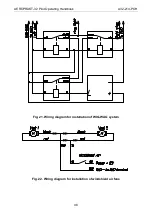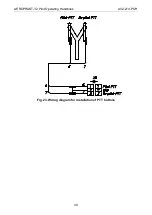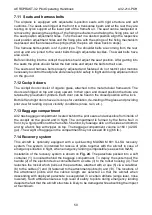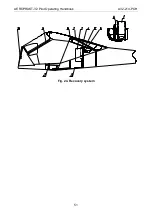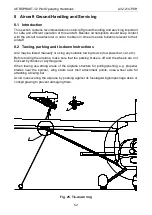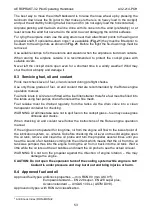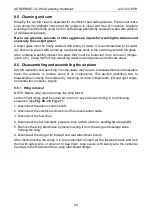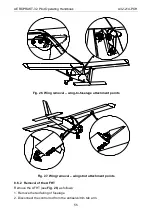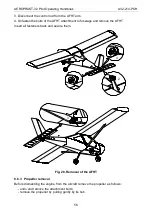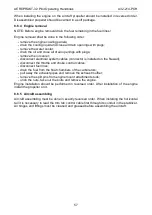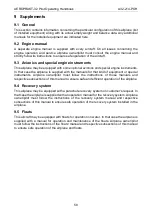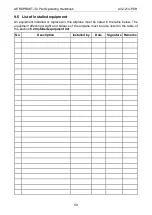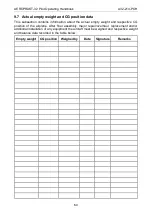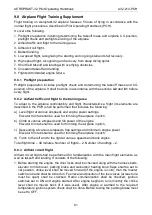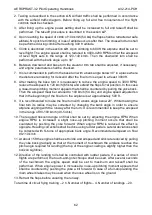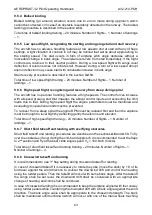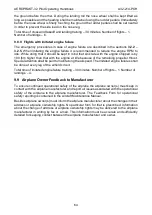
AEROPRAKT-32 Pilot Operating Handbook
A32-214-POH
62
2. Taxiing is described in the section
. Airfield traffic shall be performed in accordance
with the airfield traffic diagram. Before lining up full and free movements of the flight
controls must be checked.
3. After lining up the engine power setting shall be increased to full and takeoff shall be
performed. The takeoff procedure is described in the section
4. Upon reaching the speed of climb of 100 km/h (54 kts) the flaps shall be retracted at safe
altitude. No pitch retrimming or loss of altitude occurs after that. The crosswind turn shall
be performed during climb after reaching 300 ft altitude.
5. Climb is described in the section
. Upon climbing to 600 ft the airplane shall be set to
level flight. The engine speed shall be reduced to 4000-4200 RPM so that the airspeed
of level flight sets in the range of 120-140 km/h. Then the downwind turn shall be
performed with the bank angle up to 30°.
6. Between downwind and base turn the elevator trim tab shall be adjusted, if necessary,
and engine parameters shall be checked.
7. It is recommended to perform the base turn with a bank angle below 30° in a place where
the distance remaining for descend after the final turn is equal to at least 3000 ft.
8. After making the base turn it is necessary to reduce the engine speed to 3000 RPM,
reduce the airspeed to 120 km/h (65 kts) and extend the flaps to 1st position. In this case
a nose-down pitching moment appears that shall be countered by pulling the yoke back.
Then the airspeed must be reduced to 100 km/h (54 kts) and engine speed adjusted so
that in the beginning of the final turn the airplane is at approximately 500 ft.
9. It is recommended to make the final turn with a bank angle below 20°. While making the
final turn its radius may be corrected by changing the bank angle in order to ensure
airplane aligning with the runway after the turn. It is recommended to keep the airspeed
in the range of 90-100 km/h (49-54 kts).
10. The required descend angle on final shall be set by adjusting the engine RPM. When
engine RPM is increased a slight nose-up pitching moment occurs that shall be
countered by pushing the yoke forward. When engine RPM is reduced the effect is
opposite. Heading corrections shall be done using rudder pedals. Lateral deviations shall
be corrected with S-turns of appropriate bank angle. Recommended airspeed on final
90-110 km/h.
11. At about 15 ft the engine shall be set to idle and airspeed and sink rate reduced by pulling
the yoke back gradually so that at the moment of touchdown the airplane reaches the
pitch angle required for landing (the top of the engine cowling is slightly higher than the
horizon sightline).
12. Direction of the landing roll shall be controlled with rudder pedals. If a series of circuit
flights are performed, the touch-and-go technique shall be used. After several seconds
of the touchdown the engine speed shall be set to maximum and takeoff shall be
performed. When engine power is increased a nose-up pitching moment appears that
shall be countered by pushing the yoke a bit forward. In case of a full-stop landing the
main wheel brakes may be used when the nose wheel is on the ground.
13. Retract the flaps before vacating the runway.
Total time of circuit flying training
– 2 h. Number of flights – 4. Number of landings – 20.
Содержание A32-214-POH
Страница 25: ...AEROPRAKT 32 Pilot Operating Handbook A32 214 POH 25 No Equipment description and Part No Weight kg CG arm m...
Страница 29: ...AEROPRAKT 32 Pilot Operating Handbook A32 214 POH 29 Fig 3 Fuel system schematic...
Страница 36: ...AEROPRAKT 32 Pilot Operating Handbook A32 214 POH 36 Fig 10 Engine pre start mixture control...
Страница 43: ...AEROPRAKT 32 Pilot Operating Handbook A32 214 POH 43 Fig 15 Wiring diagram of A32 electrical system main...
Страница 49: ...AEROPRAKT 32 Pilot Operating Handbook A32 214 POH 49 Fig 23 Wiring diagram for installation of PTT buttons...
Страница 51: ...AEROPRAKT 32 Pilot Operating Handbook A32 214 POH 51 Fig 24 Recovery system...

